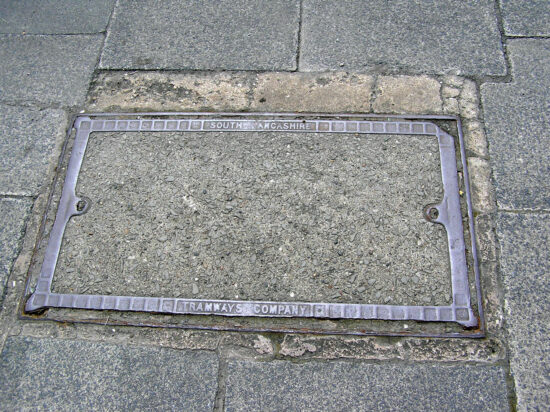After 78 editions we come to the end (for now?) of our “Still Standing” series as we take a look at old tramway infrastructure still in situ, even if it was being used for something very different to its original purpose. Throughout this series we have featured buildings, track, poles, rosettes and even section boxes nowhere near a tramway route but this is a first – it’s a manhole cover! Located in Atherton, Greater Manchester the history of its ownership can clearly be seen.
The South Lancashire Tramways Company ran from 1902 to 1933 with a 39 mile network stretching from what is now Merseyside to Greater Manchester with Atherton as the hub of the system. It has connections with through running to other tramways in the area before at the start of the 1930s the company sought powers to replace trams with trolleybuses. 3rd August 1930 saw the first route transfer operation before on 16th December 1933 the route between Leigh and Four Lane Ends became the last line to succumb.
Some parts of the South Lancashire Tramway Company are still extant today, including tram no. 65 which is in an unrestored state at the Greater Manchester Museum of Transport, but one of the more unusual – and less likely to be noticed! – survivors is this manhole cover which had an unknown purpose.
* And so that is the end of “Still Standing!” We do hope to return to this series in the future but in order for this to happen we need extra contributions to allow it to continue. So, if you know of any structure still in existence from a first generation tramway please let us know and if you can provide photos and information that is even better! To take a look at those locations previously featured you can visit the Still Standing! list at http://www.britishtramsonline.co.uk/stillstanding.html – there are some old structures we know about but haven’t featured in the series, if that’s the case then there is no link on the right-hand side otherwise each one gives a link to the original article. And if you want to go through all those articles we have run over the pasy 18 months go to http://www.britishtramsonline.co.uk/news/?cat=79 which lists every single one!


Don’t stop “Still Standing”…..please.
What a fascinating series!
I hope it will be back in the future – but as things stand I have nothing else to include in the series! Hopefully by giving it a break will allow us to come back for another set of articles at some point in the future. I’m grateful we have gone on for as long as we have as despite the various restrictions we have been living with for the past 15+ months I have still got plenty of contributions.
I agree. An excellent series indeed! The South Lancashire Tramways Co. certainly ran trams and built important tramway links, like its Haydock to Hindley section which allowed a Liverpool tramcar to make a ceremonial journey from Liverpool (Pier Head) to the centre of Bolton in May 1903, as well as the later tramway link between Monton and Worsley which made possible other exceptional journeys from one side of the county of Lancashire to the other (Manchester area to Liverpool) in the 1920s. However, the SLT also had other facets to its business. These included a Parcels Service (discontinued in 1939), and during the 1920s, the installation of both private telephone systems and the sale of domestic electrical equipment. These last two may account for this manhole cover, as the SLT probably also supplied domestic current from its power station. The SLT was also legally obliged to provide street lighting – at no cost to the local authorities – throughout the streets on which the trams operated (and later the trolleybuses too), so there may have been a tapped-off feeder supply for lighting and/or domestic installations, again relating to this cover. Incidentally, the SLT street lighting can be seen in some of the photographs of the South Lancashire trams and even by the standards of the day, it might be regarded as “feeble” consisting as it did of quite low wattage exposed bulbs in partially reflective surrounds. A waiting room in Atherton and an Inspector’s booth in Walkden were also lit by electric lights fed from the main traction feeder cables. The SLT power station at Howe Bridge was mothballed in 1948 after the nationalisation of the electricity network at which time, SLT still operated trolleybuses and kept the power station in reserve.